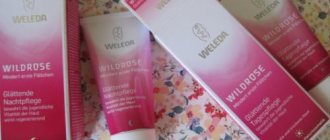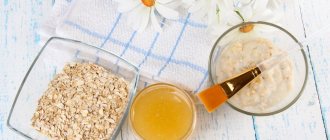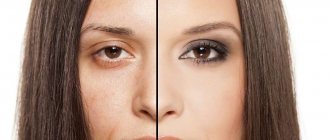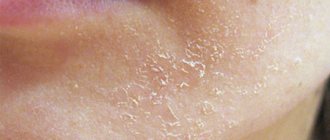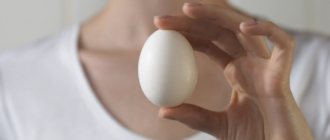Pregnancy mask: preventing age spots March 29, 2013, 00:00 | Katya Baranova
6 chosen
The mask of pregnancy, or, as it is scientifically called, chloasma, is the appearance of brown spots on the face, especially in the area of the forehead and cheekbones, around the nose, above the upper lip, around the eyes or on the temples. Such spots may appear by the fifth month of pregnancy, which is due to the combined effect of hormones (in particular estrogen), which increase the amount of melanin in the skin, and sunlight. Dark-haired women with pale skin are especially susceptible to developing the pregnancy mask.
We protect
Every day, when going outside, use a cream containing a sunscreen. If you are going for a long walk, it is a good idea to use a special sun cream with a strong protective factor. However, the best advice here can only be this: try to avoid direct sunlight.
In addition to the sun, micro-irritations of the skin can also cause a pregnancy mask. Therefore, while expecting a baby, you should not get too involved in peelings and aggressive face creams.
During pregnancy, it is very important to monitor the condition of the thyroid gland and take sufficient amounts of vitamins E, C and folic acid, as recommended by your doctor.
In the sun
Direct sunlight can aggravate hyperpigmentation of the facial skin. The spots may become brighter and more difficult to get rid of. It is especially dangerous to go out into the sun from 12 to 16 hours of the day. Of course, you shouldn't avoid the sun completely, but if you do, be sure to wear a wide-brimmed hat or cap with a visor that casts a shadow over the entire face. Apply a high SPF sunscreen (50 or more) every two hours.
It is recommended to apply an additional layer of cream to sensitive areas of the face, which is convenient to take with you - a sun stick. It looks like lipstick, fits into any purse, and is easy to use in any situation.
Getting rid of
If you were unable to protect yourself from age spots, and the pregnancy mask still appears, you should increase your efforts to protect your skin from the sun. Don't leave home without a hat and sunscreen. Talk to your dermatologist about other protection methods you can use. Often the mask of pregnancy goes away with tanning or after childbirth, which is why many doctors say that there is no need to treat chloasma during pregnancy. However, there is always a risk that during the next pregnancy or even if you tan next year, these spots will appear again. If, six months after giving birth, pigment spots on your face have not gone away, consult a dermatologist.
I offer you several tools on the topic:
| Skin Vivo Uniformity Cream for normal skin SPF15, Biotherm | Day cream SPF 40 UV Plus HP, Clarins |
| Solar superscreen for face SPF 50+, Sisley | Sunscreen for face with SPF 50, Clinique |
Katya Baranova , etoya.ru
Rules for applying masks and their effect
Based on the choice of components, you can choose the most suitable formulation, which, with regular use, will help you cope with a specific problem. There are masks that whiten age spots, remove excess fat, nourish and soften dry skin, increase its elasticity and firmness, etc. You can also find recipes for masks that have a healing effect: relieve inflammation and irritation, narrow enlarged pores, and cleanse clogged pores.
It is important to know! The main goal of any mask is to improve the condition of the skin by increasing blood circulation and nourishing the epidermis with active substances.
Before you start choosing ingredients and mask recipes, you need to know a few nuances and follow the following rules:
- all active components included in the masks are best absorbed after the skin has been steamed (after taking a bath), massage or darsonval;
- You should use only freshly prepared masks, so try to combine the amount of ingredients that will be needed for a one-time application. Otherwise, when stored, the composition will lose, if not all, then most of its beneficial properties;
- The masks are applied to well-cleaned skin, and their duration of action is described in the recipe. It must be strictly adhered to, and the remnants of the mask must be removed with a napkin and washed off with warm water.
Composition and effect of masks
The recipe for any of the face masks for pregnant women uses nutritional and medicinal ingredients, which are divided into basic and additional. The composition is often based on cosmetic clay, fresh yeast, starch, egg (white or yolk separately), etc.
During pregnancy, you should not use such known allergens as citrus fruits (no matter juice or pulp), red berries and fruits for procedures.
To feel the result, as they say, “in person,” it is worth doing the procedures in courses. For example, the bulk of nourishing, whitening and toning masks should be repeated 2-3 times a week for 3-4 weeks. After which it is recommended to take a break for one and a half months. After this, you can begin to apply the new course.
It is important to know! Any herbal-based mask (decoction, tincture) retains its healing properties for up to 5 days, provided it is stored in the refrigerator.
Preparing for application and removing the mask
If you have oily skin, then before starting the procedure you need to clean it well and wipe it with any lotion, vegetable juice or warm herbal infusion. From the latter, it is better to make a compress, which will increase blood flow and prepare the skin to absorb nutrients in full.
You can apply a mask using:
- cosmetic brush or spatula;
- a piece of gauze or a cotton swab (if the composition is liquid);
- fingers.
While the composition is active, it is recommended to put a cotton compress of cold black tea on your eyes, which will help remove puffiness and make your eyes more expressive. The mask is applied strictly along the massage lines from bottom to top to prevent stretching of the skin. During the procedure, it is advisable to remain silent and just lie quietly.
If the composition was thick and included large particles, then at the end of its action, the residues are removed with a napkin, after which the face is thoroughly washed, dried with a soft towel and rubbed with lotion. If necessary, a little later you can apply a thin layer of nourishing or moisturizing cream.
For dry skin, it is better not to wipe off the moisture, but to tap it in with light patting movements with your fingertips. Then simply place your palms on your face, which will provoke active blood flow. To enhance the effect, it is recommended to use a little rich cream at the end of the procedure.
Under no circumstances keep the composition on your face more than indicated in the recipe, so as not to harm the skin even more. This especially applies to those masks that, when frozen, form a hard film on the face.
Recipes for the simplest nourishing masks for dry skin
Below are several recipes that can quickly restore and nourish dry skin. Using these face masks during pregnancy, you can quickly restore moisture balance and refresh your facial skin. Recipes consist exclusively of available ingredients. The compositions are easy to prepare and not difficult to use.
The list of the most effective nourishing masks for dry skin includes:
- Mayonnaise. Grind the yolk, gradually adding a tablespoon of olive oil to it. Apply for 15 minutes, remove with a napkin and warm water.
- Yolk. Take the yolk of one chicken egg and mix it with a tablespoon of glycerin. Apply for 15 minutes to cleansed skin.
- Cottage cheese. Carefully mix cottage cheese and sour cream in equal quantities (1 tablespoon). Preferably homemade. The mask remains on the face for no more than 20 minutes and is washed off with warm water.
- Kefir. A tablespoon of homemade sour milk is mixed with a teaspoon of oatmeal. Apply to cleansed skin and keep until the composition dries.
Recipes for nourishing masks for oily skin
The list of effective nourishing face masks for pregnant women with oily skin:
- Yeast. 30 g of fresh wet yeast is ground to form a paste and combined with warm milk. As a result, the mask should resemble thick sour cream. Apply to the face in two layers for 15-20 minutes.
- Cucumber. The finely grated vegetable is placed in gauze and applied to the skin of the face as a compress for 20 minutes. If you are not allergic to citrus fruits, you can add a few drops of lemon juice to the cucumber.
- Protein. Beat the egg white until foamy. Keep it on the face until the first layer dries, apply the next one on top of it and the third one according to the same principle. The mask lasts for 15-20 minutes, after which it is thoroughly washed off with warm water.
- Tomato-yolk. The pulp of a small tomato is thoroughly rubbed. Add ½ yolk and flour or starch to the pulp to thicken.
It is important to know! For oily skin, masks based on yeast, protein, fermented milk products, and fruit and berry masses are considered the most effective.
Video: Facial and body skin care during pregnancy
Beautiful hair during pregnancy - secrets of safe care
Pregnant women are concerned about the question of how to take care of their hair, given the new condition. Hair care during pregnancy is very different from everyday hair care. What products can you use for your hair, and what should you avoid? We've collected all the tips from beauty experts to help pregnant women look amazing during this special period.
Hair during pregnancy
Expectant mothers notice certain changes from the very beginning of pregnancy, not only inside their bodies, but also outside.
Due to the increase in the level of female hormones, the appearance of pregnant women's hair improves, the hair gains unprecedented strength and shine, and begins to grow rapidly..
Along with this, related problems arise, such as: increased oiliness of the scalp (especially in the first trimester), sloppy regrown ends, unruly curls.
From the second trimester, a pregnant woman's hair begins to grow rapidly, which is the result of increased collagen production. In this regard, a pressing question arises: how to tidy up your hair in order to look well-groomed.
Can my hair be cut, laminated, straightened or curled?
Important! Attention and care for your hair during pregnancy will allow the young mother to look decent in the first months after giving birth, when she will be completely absorbed in the baby, and her personal time for caring for herself will be limited.
A haircut
The first internal debate that arises in pregnant women is whether to cut their hair or not. There are no physiological restrictions here. Quite the contrary. Professionals recommend trimming your curls as a form of care, getting rid of split ends in a timely manner.
However, a significant limitation for pregnant women in this matter are superstitions and omens. According to popular belief, if a pregnant woman cuts her hair, she will shorten the life of her child (there are other options). And the more radical the changes, the stronger the “return”.
But to believe in omens or not is an individual choice for each person. Stylists and hairdressers do not see any obstacles to cutting hair. In this case, an excellent compromise solution would be to cut the bangs, especially if such a hairstyle was familiar to the woman. This way, the expectant mother will be able to maintain the length of her hair and partially change her appearance without fear of signs.
Coloring
A rather thorny question for dyed blondes and those whose hair has already become silvery with gray hair. From a safety point of view, doctors have long advised against dyeing your hair during pregnancy, but it is important to consider the fact that modern dyes can be gentle.
Approved hair coloring products during pregnancy:
- ammonia-free paints;
- toning and tint shampoos;
- natural natural dyes.
Advice. If you approach the issue of choosing a coloring product thoroughly and consult with your hairdresser, then you don’t have to look for excuses for your unkempt appearance, hiding behind pregnancy. After all, gray hair and overgrown ends spoil the appearance of a woman in any position.
Every expectant mother worries about the health of her baby, and fears that harmful paint components can enter the blood through the skin, and then into the baby’s bloodstream. But you need to understand that two or three colorings with gentle pigments without ammonia will not harm the baby if you follow all the rules of the procedure.
In the first trimester of pregnancy, it is still better to refrain from any chemical effects on the scalp and hair, and even approach the choice of shampoo with special attention. But natural dyes, such as henna and basma, can be used by women at any time, which will only have a positive effect on the appearance of the hairstyle.
But to cover gray hair, you will have to use such dyes almost every two weeks. But even gentle dyes without ammonia can last on gray hair for no more than a month. Therefore, it is better to choose the highest quality and at the same time safe dye in order to resort to the dyeing procedure less often.
Extremely dyed blondes will have to choose between regrown roots and chemical lightening. Owners of light brown hair can lighten their curls by one or two tones by rinsing them with linden decoction or lemon juice solution every time they wash.
Laying
Tight ponytails, tight hairstyles, dreadlocks or afro braids are not recommended as a hairstyle for a pregnant woman. Such a rough attitude towards hair can lead to hair loss, since this problem is more common in pregnant women due to a lack of vitamins, hormonal imbalance, toxicosis and other conditions.
Wide braids, on the contrary, are perfect for pregnant women, especially since this hairstyle is now in fashion.
While waiting for the baby to be born, you should stop using hairsprays, as these care products contain many harmful components specifically for pregnant women.
Of course, if you plan to go out, you can resort to less harmful products, such as gel or hair foam. In everyday life, it is better to avoid any additional substances (except natural ones).
Attention! Styling with hot air can dry out the ends and at the same time increase the oiliness of the scalp, so it is better to dry wet curls after washing naturally or with a hairdryer in a gentle mode.
Washing head
Increased sebum production often becomes a problem for expectant mothers. Due to increased hormone levels, hair becomes oily faster. The main care tip in this case is to use mild shampoos based on natural ingredients. You should avoid shampoos, conditioners and masks with a laminating effect, as well as products containing silicone.
It is better to use shampoos based on infusions of medicinal herbs, or use homemade prescription compositions. For hair conditioning, masks made from natural ingredients and rinsing with herbal decoctions are best suited.
Safe traditional recipes
Natural products are welcome as additional hair care during pregnancy.
You can use herbal decoctions and infusions from other parts of plants for rinsing without fear. Chamomile will help in caring for oily scalp, and nettle will strengthen the scalp.
Oak bark, black tea, and onion peels will add additional color to your curls with regular rinsing.
Not all natural and essential oils are suitable for pregnant women, so before using them to strengthen hair, you need to familiarize yourself with the contraindications. It is better to exclude essential oils that can cause allergies and use only safe ones: chamomile, rose, lavender.
Masks based on natural products will be very useful during pregnancy. The following safe ingredients are suitable for preparing masks:
- honey;
- yolk;
- kefir;
- bread crumb;
- cereals.
They can be used in various combinations with vegetable oils. Burdock, flaxseed and olive oils are safe for pregnant women and can be used without restrictions.
Let's look at examples of simple recipes that are absolutely safe during pregnancy.
Home air conditioner
To reduce oily scalp, you can condition your hair by rinsing in lemon water. A liter of water and a tablespoon of lemon juice - the conditioner is ready.
Lemon juice can be replaced with food grade citric acid or apple cider vinegar.
Homemade shampoo
For washing your hair, the safest and most effective is a homemade shampoo based on eggs and soda. It is very quick and easy to prepare:
- You will need an egg and one level teaspoon of soda.
- Beat until foam forms and apply to head.
- It is important to rinse off this shampoo with warm rather than hot water so that the egg does not “curl.”
Note! Professional hairdressers recommend using gentle products without aggressive chemicals and based on natural ingredients or baby shampoos from trusted brands to wash your hair.
Onion mask for hair growth
Everyone knows about the extreme benefits of onions, but we are usually not told about the effect it can have on hair. In particular, onions can help against hair loss, for this:
- Mix the chopped onion, egg yolk and half a lemon.
- Apply the resulting mixture to the roots.
- We wrap the head in a bag and wait 30–60 minutes.
- Rinse thoroughly with warm water and shampoo.
Prohibited means and methods
When buying hair care products, you need to pay special attention to the composition. Harmful substances that can cause intrauterine harm to the baby include:
- azo dye (coloring agents, tint balms);
- hydroquinone (coloring agents);
- phthalates (styling hairspray, volume shampoos);
- triclosan (anti-dandruff agents).
Prohibited procedures during pregnancy include:
- perm;
- hair lamination and botox;
- keratin straightening.
The drugs used in such procedures are not safe for the baby’s health. Even if the master assures you otherwise, you should refuse to experiment. Formaldehyde, which is used in chemical compositions for these procedures, can cause serious harm to both the baby and the expectant mother.
Pregnancy is a special time, so it is important to understand that appearance is important, but temporary beauty should not be a priority when it comes to your baby's health. As in choosing food, so in choosing care products, the main thing is to approach it wisely, take care of yourself and your unborn child, but also not go to extremes, fearing everything in the world.
Useful videos
Kristina Khramoikina will tell you how to care for your hair during pregnancy.
What beauty procedures are allowed for pregnant women, see the following video.
Source: https://ExpertPoVolosam.com/uhod/beremennost
Getting rid of acne during pregnancy?
- First of all, in the morning and evening, cleanse your skin using a special gel or foam for washing.
- A good helper is white, blue or green clay, masks from which should be made every 3-4 days. Clay perfectly absorbs sebum and draws out all impurities from the pores, and in addition, has an antibacterial effect. Dilute a small amount of clay purchased at a pharmacy with warm water to a paste and apply to the face for 20 minutes. Remove the mask with a damp cotton swab or pad and wipe your face with salicylic acid lotion.
- Fermented milk products will also help in the fight against rashes, preventing the spread of harmful microbes and soothing the skin. Try applying kefir or whey to your face for several days after each wash. 5 minutes is enough, after which moisturize the skin with your usual cream. Just remember, kefir must be natural, without any fruit additives or preservatives.
- For problem skin, a variety of yeast masks are also good. Yeast can be mixed with milk, mint infusion, or chamomile decoction. Mix the selected ingredients to obtain a homogeneous mass and apply the mask to your face. The mixture should be approximately body temperature. In 15-20 minutes the yeast will harden, so you can simply remove it from the skin with your hands (then you should still wash your face). Repeat the procedure once a week for several months, and the result will certainly not disappoint you.
- Finally, another recipe for a mask for problem skin: take half a glass of long grain rice, pour a glass of warm boiled water, cover and leave for 2 hours. After this time, drain the water, add 100 g of white cabbage, previously pureed, and mix thoroughly. This mask should be applied to the face in a thick layer and left for 15-20 minutes. The composition is washed off with cool water, after the procedure, as usual, the skin is lubricated with a moisturizer.
Dry skin in pregnant women
Many women during pregnancy complain of dry skin, flaking, and increased sensitivity. This phenomenon most often occurs in and is believed to be the result of a decrease in estrogen levels in the blood, which weakens the protective functions of the skin. To get rid of discomfort, you will have to regularly moisturize your skin, and one cream, alas, will not be enough.
- Of the variety of moisturizing masks, those based on vegetable oils deserve special attention. Olive oil has proven itself best, however, if you don’t have it on hand, regular sunflower or flaxseed oil will do. You can wipe the skin with oil after cleansing or, combining it with pureed vegetables, prepare special moisturizing compositions. An oil mask with mashed white cabbage will be good - the mixture is applied to the skin in a thick layer and left for 15-20 minutes. The yolk-chamomile mask also perfectly moisturizes: the yolk of 1 egg is thoroughly ground with 1 teaspoon of oil and 1 teaspoon of chamomile extract. The mixture is also applied for 15-20 minutes; it can be washed off with either water or, for example, the remaining chamomile infusion.
- A classic of the genre, a cucumber mask will also help your skin cope with dryness and flaking. You can simply put cucumber slices on your face and lie down for 20 minutes. Or experiment and, after grating the cucumber on a fine grater, add 1 tablespoon of sour cream. An excellent alternative to cucumber is chopped lettuce, rich in vitamins and beneficial microelements. As you yourself understand, all products must be fresh (those from the garden are ideal).
- Various masks with herbs - calendula, yarrow, coltsfoot - are also useful for dry skin. Herbal infusions can be purchased at the pharmacy. Grind them in a coffee grinder, mix, for example, with oatmeal (also crushed), add a couple of drops of vegetable oil and apply on your face for 15-20 minutes. You can also add sour cream, cottage cheese - in general, use your imagination to suit your taste. Just be careful, because herbal extracts cause an allergic reaction in some women. “Work” only with what is familiar to you and definitely will not cause harm.
Hair loss during pregnancy
During pregnancy, you can encounter not only skin problems, but also such an unpleasant phenomenon as hair loss. Don’t panic ahead of time - for most women, after giving birth, the process stops, and the hair takes on a healthy and attractive appearance. However, if you wish, you can carry out additional “therapy” for your hair - good care is always helpful.
- The simplest and most effective remedy that restores hair strength, elasticity and prevents hair loss is burdock oil, the healing properties of which have been known for a long time. Apply the oil at night and go to bed with a cap on your head. The next morning, after washing off the composition, you will see that your hair has become softer and shiny. To obtain maximum effect, the procedure will have to be repeated several times.
- A kefir mask is very common - it softens dry, coarse hair, and also heals the hair follicles. Apply the product to washed and wrung-out hair, distribute over the entire length and rub into the scalp in a circular motion, making a light wash. Then cover your head with cling film, wrap it in a soft towel and leave for 10-15 minutes. Rinse off the mask with warm water; there is no need to apply balm after it.
- Regular bread crumb also restores hair well. Crumble a couple of slices of rye bread, pour boiling water over it and let it brew for 5-10 minutes, then add 2 raw yolks. Apply the mixture to damp hair, rub well and cover with plastic. Keep the mask on for about half an hour. With regular use, it will accelerate hair growth and improve its quality.
- A cream mask is useful for strengthening hair: mix 2 tablespoons of fresh cream with 2 teaspoons of lemon juice, add 1 teaspoon of crushed wheat grains. The composition is applied for 20 minutes and washed off with water at room temperature. Sometimes crushed garlic is included in this recipe, but due to its specific smell, such a mask is not suitable for everyone. The same applies to onions - any strong-smelling ingredients are used only in the evening, and after using them it’s a good idea to spray your hair with an aromatic spray.
Sensitive skin in pregnant women
As you know, during pregnancy the sensitivity of the skin increases significantly, and therefore even the most innocent at first glance products can cause redness, itching and even swelling, in particular. In this regard, do not use potential allergens such as honey and strawberries for homemade masks; monitor the expiration dates of cottage cheese, eggs and other ingredients used. Do not overexpose the masks - most of them are applied for a maximum of 20 minutes. If you feel a strong burning sensation, wash off the composition without waiting for the specified time to expire. If your skin was especially tender and vulnerable before pregnancy, it makes sense to first try the mask on the back of your wrist or on the crook of your elbow. Did your skin react normally? In this case, feel free to apply the drug to your face. If irritation appears or a feeling of tightness occurs, do not experiment and choose another remedy.
Clay is an excellent antiseptic. It has anti-inflammatory, stimulating and regenerating properties. Clay is able to absorb fats and liquids and perfectly eliminates skin imperfections. It comes in white, blue, green, pink, red, grey, yellow and even black. Each variety has its own special properties.
For example, white clay has regenerating properties, improves complexion, and also perfectly fights acne. Blue clay is a storehouse of anti-inflammatory properties. In addition, it fights cellulite.
Green clay is excellent for deep cleansing, and also regenerates and nourishes the skin, tightens enlarged pores. Green clay can restore facial contours and tighten skin.
Pink clay strengthens nails, and gray clay perfectly moisturizes the skin. Red clay is indispensable for sensitive and prone skin.
Yellow clay has anti-acne and exfoliating properties. Black clay fights toxins in the body, which is why it is often used for body wraps.
Problem 2 – Acne in pregnant women
In scientific language, this symptom is called chloasma, its essence is the formation of brownish pigment spots on the face, neck, and décolleté. This is a fairly common phenomenon, the reasons for which lie in increased levels of estrogen and progesterone, which, in turn, provoke increased production of melanin.
If the pigment were produced evenly, during pregnancy the skin would be covered with a chocolate tan, however, alas, not all epidermal cells respond to the action of hormones - hence the peculiar “spotty color”. It is impossible to completely get rid of chloasma during pregnancy, because most effective whitening preparations contain substances that are dangerous to the fetus and are therefore prohibited.
The same applies to a variety of salon procedures that promise to return impeccable whiteness to the skin in a couple of sessions. In addition, for many, age spots go away on their own after childbirth, although, of course, the situation can and should be slightly adjusted. First of all, limit your exposure to the open sun and on a clear day do not leave the house without applying sunscreen to your face and décolleté. Well, secondly, try making homemade whitening masks from natural products available in the refrigerator.
- Your first assistant is freshly squeezed lemon juice. Soak a cotton pad in it and wipe the skin. Repeat the procedure 2-3 times a day until the stain lightens. True, this folk remedy also has a serious drawback - it dries out the skin quite a lot. So don’t forget to use moisturizer morning and evening, and spray your face with thermal water throughout the day.
- Potatoes also have bleaching properties. To prepare the mask, grate 1 raw peeled potato on a fine grater, add a couple of drops of olive oil and 1 tablespoon of fresh milk. Stir until it becomes a liquid paste and apply to the face for 20 minutes, then rinse off the mixture and lubricate the skin with your usual cream.
- Another recipe: cucumber mask - grate a medium-sized cucumber on a fine grater and mix with 3-4 tablespoons of sour cream. To get a more pronounced effect, add a teaspoon of lemon juice here - this mask effectively copes with excessive pigmentation, and due to the action of sour cream, it also softens the skin and makes it velvety to the touch.
- Cottage cheese is also useful for chloasma, not only for internal but also for external use. Mix 2 teaspoons of fresh cottage cheese with the raw yolk of 1 egg until a homogeneous mass is formed, add 2 drops of hydrogen peroxide (using a pipette). Apply the mask to cleansed skin and keep for 10-15 minutes. This mixture should be washed off with cool water to invigorate the skin and restore its tone. It’s good to make a curd mask in the morning - it not only brightens the skin, but also returns a healthy glow to it and energizes it for the whole day. However, to achieve a noticeable result, as you yourself understand, you will have to make natural masks regularly, at least once a week for a couple of months. Although even in this case, folk cosmetology can hardly promise you complete relief from age spots - unfortunately, even the best and most delicious recipes are powerless against the action of hormones. Of course, masks will help improve the condition of your skin and make it a little lighter, but just in case, have a good foundation on hand. With its help, you can easily hide all temporary flaws and feel much more confident.
Care during pregnancy is necessary, otherwise pimples, acne... All these are names for the same skin disease, the manifestations of which are to one degree or another familiar to everyone. Whether we are talking about small reddish rashes or rare but large pustules, this disease causes great discomfort and can ruin the impression of even the most pretty face.
What clay can a pregnant woman use?
During pregnancy, any clay can be used for cosmetic purposes, as long as it is clean. It is best to buy clay at a pharmacy.
The maximum result from the use of clay is observed in the form of cosmetic masks. You just need to choose the type of clay that is most suitable for the skin; if there is no specific color of clay, you can take any one. It is only important to remember that the masks must be prepared in ceramic or glass containers (not iron) to avoid oxidation.
For greater results, various ingredients are often added to clay masks: lemon juice, oatmeal, cucumber juice, herbal decoctions. In addition to skin problems with enlarged pores, acne, increased fat content, while expecting a baby, you may encounter problems such as papillomas on the chest and neck, as well as varicose veins. You can get rid of them by making lotions, clay compresses with grated garlic. Thus, constant skin care using clay masks will allow a pregnant woman to be young and attractive.
There are no contraindications to using clay during pregnancy. The only limitation is individual intolerance, expressed in the appearance of allergic reactions.
Pregnancy is a very important and rather difficult period in a woman’s life. Some changes appear in the body that affect both health and appearance in general, including hair, skin and nails. However, women want to be charming and attractive at any time. Therefore, constant care is necessary, especially for the skin.
Pregnant skin: needs careful care
They appear in the center of the forehead, on the back of the nose, above the upper lip and on the chin (centrofascial chloasma), on the cheeks, temples, wings of the nose (molar), on the corners of the lower jaw (mandibular).
Individual spots quickly merge into one, forming a kind of “mask”. In fact, the skin is colored not only on the face: the area of the so-called “white line of the abdomen” (the strip from the pubis to the navel) darkens, the areola darkens and increases in size, dark spots appear on the inside of the thighs and under the armpits. All these are phenomena of the same nature, but changes on the face, for obvious reasons, are most disturbing.
Most often, age spots on the face appear in the second trimester, approximately in the fifth month of pregnancy, but they can appear earlier or later. They are more common in dark-haired women, especially those with dark or easily tanned skin, and much less common in natural blondes and redheads.
So, our skin (as well as hair and the pigment layer of the retina) is colored by melanin, synthesized by special cells - melanocytes. Some hormones, such as estrogen and especially progesterone, activate melanocytes and they begin to produce more melanin. In a pregnant woman, the level of progesterone in the body is an order of magnitude higher, and accordingly, side effects appear in the form of unwanted pigment spots.
The hormone melanotropin directly affects the production of melanin. Its content in pregnant women is also increased. Perhaps the reason for this is that in expectant mothers the pituitary gland increases adrenocorticotropic hormone (ACTH), which stimulates the production of melanotropin. Finally, perhaps the “last” straw may be the hormones that the baby himself begins to produce.
During pregnancy, any clay can be used for cosmetic purposes, as long as it is clean. It is best to buy clay at a pharmacy.
The maximum result from the use of clay is observed in the form of cosmetic masks. You just need to choose the type of clay that is most suitable for the skin; if there is no specific color of clay, you can take any one. It is only important to remember that the masks must be prepared in ceramic or glass containers (not iron) to avoid oxidation.
For greater results, different ingredients are often added to clay masks: lemon juice, oatmeal, cucumber juice, herbal decoctions. In addition to skin problems with enlarged pores, acne, increased fat content, while expecting a baby, you can encounter problems such as papillomas on chest and neck, as well as varicose veins.
There are no contraindications to using clay during pregnancy. The only limitation is individual intolerance, expressed in the appearance of allergic reactions.
During pregnancy, a woman’s body experiences significant stress, so special care is necessary. You should also add face masks to your daily cleansing, toning and moisturizing routine. They will help restore your skin's former elasticity and flawless appearance. An important requirement is that all cosmetics used during pregnancy be hypoallergenic.
No matter what skin problems you encountered during pregnancy, specially selected face masks will help solve them. Many women do not know what types of face masks there are. In fact, everything is simple - for every significant skin problem there are different types of face masks.
They say pregnant women glow from the inside. Yes, some really look enchanting and gorgeous. But most experience all the “delights” of pregnancy and cannot boast of clear, beautiful skin. The main problem for women in an “interesting situation” is age spots. They form in open areas - face, neck, décolleté.
The reason for the unaesthetic phenomenon lies in the excessive production of melanin due to the increased concentration of the female hormones progesterone and estrogen in the body. Some areas of the epidermis overreact to hormonal levels, which is why they become darker. Many women during pregnancy complain of skin rashes - acne.
The reason again lies in a specific hormonal background: the overactive functioning of the endocrine system provokes the sebaceous glands to secrete more sebum, the pores become dirty, clogged and blackheads, small pimples and even large ulcers appear. It even covers those who previously had dry skin, let alone oily skin.
Pimples can ruin even a pretty face and cause tears and bad mood for many pregnant women. The other extreme that hormones “give” expectant mothers is dry and sensitive skin. In the first trimester, peeling, dryness, tightness, redness and swelling appear. And, unfortunately, a regular moisturizer or special cosmetics for sensitive skin will not be enough here. Masks can help solve a number of specific women's skin problems.
The answer to this question is definitely yes, and the more often the better. With them, the skin will become smooth, silky and maintain its tone and attractive appearance. Problems such as pigmentation, swelling, peeling and acne will completely disappear only after childbirth, but with the help of masks you can minimize the harm. However, not every face mask is suitable for an expectant mother.
We suggest you read: Can Contractubex be used for pregnant women?
Is it possible to make masks for pregnant women from a drug purchased in a retail chain or from a well-known brand? At a minimum, it is not recommended. Such masks contain chemical compounds that are dangerous to the fetus. And, as we know, what gets on the mother’s skin eventually ends up in the fetus’s body. Whitening masks that contain aggressive substances are completely prohibited.
Is it possible to make face masks for pregnant women if the drug is purchased at a pharmacy? Pharmacy products are not always healthier and more natural than those that can be found among the assortment of well-known brands. However, pharmacies often have special cosmetics for pregnant women that do not contain hazardous substances. This is exactly what you need.
There is a list of products that are indicated for use in maternity masks. They will help solve typical skin problems without harming the fetus: 1. Lemon. Rubbing the skin with lemon juice is recommended to lighten it, fight pigmentation, and also to dry out pimples and remove blemishes. 2. Potatoes.
Fresh potato gruel is an excellent moisturizer, suitable for refreshing sensitive skin and getting rid of age spots. 3. Cucumber - well moisturizes and whitens, gentle. 4. Cottage cheese - a mask with the addition of egg yolk whitens the skin, and the protein will help fight acne. 5. Yeast - will refresh the appearance, remove excess fat, flaking, redness, nourish and moisturize. Don't count on quick results. However, if you make masks constantly, several times a week for a month, the results will be obvious.
During pregnancy, a woman undergoes special changes in her body, so she needs to take especially careful care of her health. Most often, the skin suffers and the hair structure is disrupted. Products made from natural ingredients will help restore them to their former elasticity and beauty, as well as a healthy appearance - they do not cause allergies and saturate the body with vitamins and beneficial microelements. Can pregnant women make face masks?
The effectiveness of the treatment will depend on the correctly selected mask - it must be chosen taking into account the woman’s skin type.
In order for the result after applying the mask to be good, you need to know several rules.
- It is advisable to prepare masks before use so that they do not lose their beneficial properties.
- The mask must be applied to clean, pre-steamed skin. So that it penetrates as deeply as possible into the pores and cleanses them.
- It is advisable to distribute the product with a sponge or brush.
- It is recommended to apply the mask along massage lines.
- It is advisable to wash off the cosmetic product with herbal infusions. They have a beneficial effect on the skin, providing a calming effect.
- After using the mask, it is advisable to apply moisturizer to the skin.
Facial skin problems that occur during pregnancy
In pregnant women, pigmented brown spots appear on the skin of the cervical region, face and décolleté. This happens because the body intensively produces the pigment melanin, and therefore the level of progesterone and estrogen increases. The main problem with these spots is that it is impossible to cure them during pregnancy, since all lightening preparations contain harmful substances, the use of which is prohibited during pregnancy.
Pimples and blackheads that appear on the face also cause quite a lot of trouble. This happens due to the active functioning of the endocrine system, when increased secretion of large amounts of sebum contributes to clogging of pores and the onset of the inflammatory process. Also, quite often women during pregnancy experience dry skin, which causes high sensitivity and flaking.
Decorative cosmetics. How to paint your face during pregnancy
Pregnancy is the right time to switch to mineral decorative cosmetics. Minerals are as neutral as possible. Mass market and professional cosmetics contain toxic components, harsh preservatives and potential allergens to which the skin may not have previously reacted. Now that the immune system is already weakened, their presence in cosmetics can become a problem. Therefore, minerals are the best decorative cosmetics for pregnant women.
Summarize
Facial care during pregnancy should be gentle, with the most natural ingredients possible. No hardware procedures, a minimum of aggressive components that penetrate deeply into the skin.
Direct your energy to gently cleansing and maintaining the natural immunity of the skin. After childbirth and the end of lactation, all serious cosmetics and procedures will be not only safer for you, but also more effective.
Love yourself, stay beautiful and enjoy your “interesting position”.
Ask questions and share your tips for facial care during pregnancy in the comments.
Summarize
Love yourself, stay beautiful and enjoy your “interesting position”.
Whitening masks
1. Fresh lemon juice will help lighten problem areas on your skin. You need to soak a piece of cotton wool in it and wipe your face a couple of times a day. Although this is the simplest method, it has its drawbacks. The fact is that lemon juice has drying properties, so after using it you need to moisturize the skin with any light cream.
2. Grated cucumber with sour cream will also help you get rid of age spots. It is recommended to add a little more lemon juice - in this case, the sour cream will more effectively moisturize the skin and make it soft and tender.
3. Potatoes also have bleaching properties. You need to grate it, add a few drops of olive oil, one spoon of milk, apply it to your face and leave for 20 minutes. Just like after any mask, you need to use cream at the end of the procedure.
Degreasing masks
The main ingredient in most masks for acne and oily skin is clay. It cleanses dirty pores well and has anti-inflammatory and antibacterial properties.
Clay can be white, blue and green. .
- The green clay mask can be used for any skin type. You should dilute it in warm water, add cucumber pulp, then spread it on your face and rinse off after 15 minutes.
- It is also permissible to experiment with adding various ingredients to the diluted mass: yolk, lemon essential oil and aloe juice.
Masks for acne and pimples can be made without clay
- We will need yeast, mint infusion or calendula decoction. Mix the ingredients, apply to the face, and leave for 20 minutes. Such masks should be made over several months.
- Leave half a glass of long-grain rice to steep in warm water, covered, for two hours. Drain the water, add 100 grams of white cabbage puree and distribute. For a stronger effect, the mask lasts up to 15 minutes.
Moisturizing masks
During pregnancy, it is very important to moisturize your facial skin. Effective moisturizing masks often contain vegetable oils. Olive oil is ideal for this purpose, but if you don’t have it, you can easily find an alternative, such as sunflower or flaxseed.
- For the first mask we will need to make porridge from white cabbage. Mix it with olive oil, apply a thick layer to the face and leave for 20 minutes.
- Add one teaspoon of vegetable oil and chamomile extract to the mashed yolk. You can wash off this mask not only with water, but also with chamomile decoction.
- Herbal infusions are also great for moisturizing the skin. At the pharmacy you can buy herbs such as calendula, coltsfoot, yarrow. Add ground oatmeal and vegetable oil to the crushed herbs, then apply to the face. But when using herbs, you need to remember that they can cause an allergic reaction, so you should conduct a sensitivity test to this product in advance.
- You can also use pumpkin and apples during pregnancy. Beat the boiled pumpkin and apple in a ratio of two to one and add olive oil to this mixture. It is recommended to keep this mask on your face for 15 minutes.
Rules to remember when using masks
By adhering to the following rules, face masks will definitely benefit your skin:
- You need to prepare masks immediately before use.
- Before application, clean and steam the skin well.
- The best method is to steam the skin over hot water.
- To distribute the mask over the face, it is advisable to use a brush or cotton pad. If there is none of the above, then you can apply the product with your fingers.
- Masks are distributed only along massage lines.
- At the end of the procedure, you should use a light moisturizer.
During pregnancy, a woman’s body experiences significant stress, so special care is necessary. You should also add face masks to your daily cleansing, toning and moisturizing routine. They will help restore your skin's former elasticity and flawless appearance. An important requirement is that all cosmetics used during pregnancy be hypoallergenic.
No matter what skin problems you encountered during pregnancy, specially selected face masks will help solve them. Many women do not know what types of face masks there are. In fact, everything is simple - for every significant skin problem there are different types of face masks.
Daily facial care during pregnancy

Facial skin often changes during pregnancy. Most often it becomes either too dry or too oily. Therefore, it is worth thinking about building a new care program.
In addition, care should be gentle. It is better to leave the use of serious anti-aging products and aggressive products for problem skin for later. Such cosmetics contain active ingredients, many of which are included in the list of products not recommended during pregnancy.
Let's talk in detail about the three basic stages of facial care and their features during pregnancy.
Makeup removal and cleansing
To remove makeup, use the most natural products with a “simple” composition, for example, micellar water. Milk is ideal for dry skin. It will not dry out, but rather additionally moisturize and soothe.
To wash your face during pregnancy, be sure to get a sulfate-free foam or gel. There should be no components with the word sulfate on the label. Instead of sulfates, soft surfactants should be present, for example: cocamidopropyl betaine, sodium cocoate, sodium cocoamphoacetate, lauryl glucoside.
These products will gently remove dust and sebum without damaging the epidermal barrier.
Toning
From post to post, we will not tire of repeating that toning is a hyper-important stage of daily care that cannot be neglected. In short, toners restore the natural pH of the skin after contact with water and maintain the skin's protective barrier. (Read more about toning in the post “Tonics vs. Lotions”).
Avoid medicated and alcohol-based lotions. Excessively active components are not recommended for pregnant women, and alcohol greatly dries the skin and can additionally provoke pigmentation.
Choose a light tonic that is as natural in composition as possible. Hydrolates are good. But remember that they all have a mild but rather specific “plant” odor, which can cause discomfort in pregnant women. Better to smell before buying.
We suggest you read: You can have borscht with guards - I'm pregnant
Regardless of skin type:
- In cold weather, we apply a nourishing cream in the morning and a moisturizing cream at night.
- in warm times (when the temperature starts to stay above 7) - nutrition at night, and hydration in the morning.
During pregnancy, pay attention to neutral creams from pharmacy brands. Their advantage for expectant mothers is high-quality, but not very active ingredients. The mass market often sins with cheap and dubious preservatives. And professional creams are usually saturated with active ingredients, which we have absolutely no use for now.
When we talk about the neutrality of the cream, we mean not only the absence of allergens (essential oils, strong fragrances, etc.), but also that the cream performs only basic functions - nutrition and moisturizing, but does not solve specific skin problems - that is, it does not whiten , does not mattify, does not fight acne, etc. Leave the solution to these problems for later. Now it is important to maintain the natural health of the skin.
A cream with hyaluronic acid or aloe is ideal for moisturizing, and natural oils for nutrition.
Makeup removal and cleansing
To wash your face during pregnancy, be sure to get a sulfate-free foam or gel. There should be no components with the word sulfate on the label. Instead of sulfates, soft surfactants should be present, for example: cocamidopropyl betaine, sodium cocoate, sodium cocoamphoacetate, lauryl glucoside.
Toning
Dry skin
Every second woman complains of dry and flaky skin during pregnancy. Most often, you encounter such a nuisance in the first 3 months of pregnancy, when hormonal changes in the body occur and the level of estrogen in the blood decreases. The natural result of such changes is increased skin sensitivity. You can solve problems by moisturizing, but moisturizing cream alone is not enough; you need to use a special face mask.
Recipes for face masks for dry skin are very varied. But almost always the composition contains vegetable oil, which provides active hydration of the epidermis. A few simple recipes that can be used during pregnancy:
Be careful, herbal face masks can cause an allergic reaction in some cases. During pregnancy, you should pay special attention to the selection of cosmetics.
Dry skin in pregnant women
Many women during pregnancy complain of dry skin, flaking, and increased sensitivity. This phenomenon most often occurs in the first trimester of pregnancy and is believed to be the result of a decrease in estrogen levels in the blood, which weakens the protective functions of the skin. To get rid of discomfort, you will have to regularly moisturize your skin, and one cream, alas, will not be enough.
- Of the variety of moisturizing masks, those based on vegetable oils deserve special attention. Olive oil has proven itself best, however, if you don’t have it on hand, regular sunflower or flaxseed oil will do. You can wipe the skin with oil after cleansing or, combining it with pureed vegetables, prepare special moisturizing compositions. An oil mask with mashed white cabbage will be good - the mixture is applied to the skin in a thick layer and left for 15-20 minutes. The yolk-chamomile mask also perfectly moisturizes: the yolk of 1 egg is thoroughly ground with 1 teaspoon of oil and 1 teaspoon of chamomile extract. The mixture is also applied for 15-20 minutes; it can be washed off with either water or, for example, the remaining chamomile infusion.
- A classic of the genre, a cucumber mask will also help your skin cope with dryness and flaking. You can simply put cucumber slices on your face and lie down for 20 minutes. Or experiment and, after grating the cucumber on a fine grater, add 1 tablespoon of sour cream. An excellent alternative to cucumber is chopped lettuce, rich in vitamins and beneficial microelements. As you yourself understand, all products must be fresh (those from the garden are ideal).
- Various masks with herbs - calendula, yarrow, coltsfoot - are also useful for dry skin. Herbal infusions can be purchased at the pharmacy. Grind them in a coffee grinder, mix, for example, with oatmeal (also crushed), add a couple of drops of vegetable oil and apply on your face for 15-20 minutes. You can also add sour cream, cottage cheese - in general, use your imagination to suit your taste. Just be careful, because herbal extracts cause an allergic reaction in some women. “Work” only with what is familiar to you and definitely will not cause harm.
Dark spots
Dry skin is not the only problem that women face during pregnancy. Many people complain about the appearance of age spots, which is caused by increased production of melanin under the influence of hormones. Spotting causes a woman a lot of inconvenience and greatly affects her self-esteem, but it is impossible to completely whiten her face.
Visits to a beauty salon are also contraindicated during pregnancy. Cosmetics used in salons contain many harmful additives that are absolutely contraindicated during pregnancy.
During this important period, it is necessary that all cosmetics be hypoallergenic, so it is better to make face masks from natural products:
- Use lemon juice 2 times a day. Facial masks based on lemon juice whiten well, but have a significant drawback - drying out. To reduce negative consequences, it is necessary to use a moisturizer or thermal water after each procedure.
- Grate raw potatoes, add 1 tbsp. l. milk and vegetable oil. Apply the resulting mixture for a quarter of an hour.
- Mix finely grated cucumber, sour cream and lemon juice. Spread the resulting mixture evenly on your face.
- Mix the yolk with 2 tbsp. l cottage cheese. Add a few drops of hydrogen peroxide.
Pigment spots may be present unevenly, so sometimes it is advisable to apply a whitening mask to the floor of the face. With regular use at least once a week, face masks based on natural products will help achieve noticeable results. The spots will lighten, a healthy glow will appear, the skin will be elastic and fresh. And most importantly, cosmetics that help achieve such results are hypoallergenic and do not contain harmful preservatives.
You should not resort to radical methods; annoying spots will disappear after the end of pregnancy. Face masks will help maintain skin condition during this period.
Hair masks during pregnancy
Loading...
While carrying a child, a woman’s body is constantly being rebuilt; most girls and women often have problems with their hair during this period.
Many representatives of the fair sex are starting to buy various hair care products in cosmetic stores. But such means may not always have a beneficial effect on the baby’s development.
An alternative solution to the problem is homemade remedies.
Today we will talk about whether pregnant women can make hair masks. We’ll tell you in more detail what the advantages of homemade formulations are, and also provide several recipes and tips for caring for your curls.
Pregnancy and hair masks: is it possible?
There are many reasons for hair loss, especially if a woman is in an “interesting position.” The following are considered the most basic:
- reduced immune system;
- lack of vitamins and required micro and macroelements;
- changes in hormonal levels;
- chronic diseases and their exacerbations.
At this time, it is very important to pay attention and begin to eliminate the health problem in time, and it is recommended to use masks as an additional treatment.
Many expectant mothers ask what masks can and are allowed to be applied to pregnant women? We answer that the composition of the product should be made exclusively from natural and environmentally friendly ingredients.
As a rule, homemade hair masks for pregnant women bring exceptional benefits, without harm to the body. Let's look at the benefits of such compositions for curls:
- eliminate excessive hair loss;
- have a strengthening effect on the hair follicle;
- normalize the functioning of the subcutaneous glands, due to which the hair does not become dirty for much longer;
- have a healing effect on the ends of the hair;
- improves appearance, gives natural shine;
- normalize hair growth.
The main advantage of homemade formulations is that they penetrate deeply not only into the hair itself, but also into the lower layers of the scalp. At the same time, they do not cause any harm to both the woman herself and her unborn child. Therefore, pregnant women can make hair masks at any time, unlike store-bought products.
Particular attention should be paid to the medications that are allowed to be used to prepare masks. It is forbidden to use nicotinic acid (although masks with nicotinic acid are very useful for hair) and demixide, since these drugs have a restriction in their contraindications - “not allowed to be used during pregnancy and lactation.”
You need to choose a recipe for a home remedy during pregnancy very carefully, based on your individuality and not forgetting about the possible manifestation of an allergic reaction. If an allergic rash appears after using the product, it should be washed off immediately and not used again.
In what cases is it especially recommended to use masks during pregnancy:
- seborrhea, dandruff;
- hair quickly becomes oily;
- excessive hair loss;
- stunting;
- brittle and very dry curls;
- dull and lifeless hair.
Rules for using masks during pregnancy
In order for the effect of home procedures to be noticeable immediately, you need to know several rules for use:
- You need to use a homemade composition for curls at least once a week. Depending on the components of the mask, some of them can be done up to 3 times.
- Before applying the composition to your curls, you need to make sure that it will not cause you an allergic reaction. This is quite easy to do. Apply the composition to the most tender place on the hand and leave for 10 minutes. If during this time redness or itching does not appear in this place, then feel free to apply it to your head, otherwise you should not apply it.
- It is recommended to wash off such compositions with a small addition of natural shampoo. It’s not difficult to make, the main thing is to choose the right recipe for your hair type. The water for removing mass from curls should be warm, but under no circumstances hot.
- As a rinse, cosmetologists recommend using a decoction of medicinal herbs (chamomile, calendula, nettle and others), a solution with a small addition of lemon juice or any fruit vinegar, and it is also allowed to rinse your hair with simple freshly brewed green tea.
- You cannot use various styling products, or use electrical devices for drying and styling (hair dryer, electric curling irons, curling irons, etc.). It is better to keep your curls loose than to braid them.
- Avoid temperature changes. In the summer, go outside strictly in a hat.
- Before going to bed, it is recommended to do a small head massage.
- You need to comb your hair with a wooden comb or a brush made of natural wood. You need to comb your hair up to 5 times a day.
Recipes for masks for pregnant women
- Egg mask for hair loss.
Chicken or quail eggs contain a significant amount of useful substances and vitamins, which perfectly help cope with excessive hair loss.
To do this, take an egg (1-2 pieces, depending on the length of the hair) and beat it thoroughly, preferably until foam forms. Distribute evenly throughout hair and leave for 30 minutes, preferably warming. Remove with warm water.
We can also recommend homemade masks made from quail eggs, which will help eliminate small wrinkles and relieve swelling.
- Hair mask for pregnant women with a moisturizing and restorative effect.
Olive oil is considered an excellent moisturizer and restorer. It is especially useful to use for very dry hair, as well as for restoring split ends.
Once a week, it is recommended to apply simple oil to your curls and leave for 10 minutes. While waiting, it is best to give a light head massage. Wash off with natural shampoo and rinse with chamomile decoction.
To restore the ends, the oil needs to be warmed up a little. Generously lubricate damaged curls and leave for half an hour. We wash off in the same way.
- For dry curls:
• grape seed oil - 10 ml; • jojoba ether - 2 tsp;
• almond essential oil - 1.5 tsp.
Combine all the above components and heat slightly. Apply to the head, insulate and leave for half an hour. Wash off with shampoo and rinse with lemon water. It is recommended to apply this oil mixture 1-2 times every 7 days.
Some advice for expectant mothers
In order for your curls to always be beautiful, manageable and not fall out, you must follow several rules:
- Use only natural-based hair care products.
- During pregnancy, you need to apply hair masks 1-2 times a week.
- During pregnancy, you should avoid dyeing and perming your hair. These procedures will only worsen the situation, and in some cases even harm the unborn baby.
- Eat properly and balanced.
- Take complex vitamins.
- Protect hair from direct sunlight.
Loading…
Source: https://HairFace.ru/maski-dlya-volos-pri-beremennosti.html
Skin rashes
Acne is another trouble that can befall pregnant women. And small, unnoticeable pimples do not always appear. Quite often these are whole abscesses that spoil the mood and require immediate intervention.
There's no need to worry, you're fine. Simply, under the influence of hormones, excess amounts of sebum are produced, which causes clogged pores. Special hypoallergenic cosmetics will help to cope with such skin problems. Care procedures are as follows:
After removing any product, be it a scrub or a cleansing mask, you need to apply a moisturizer to your face.



